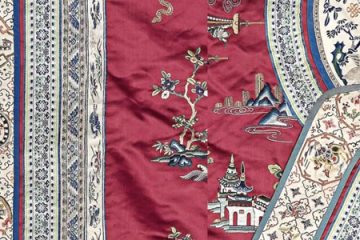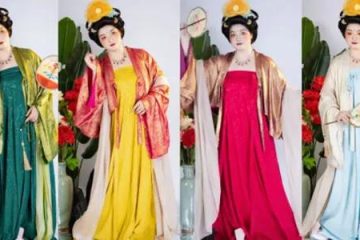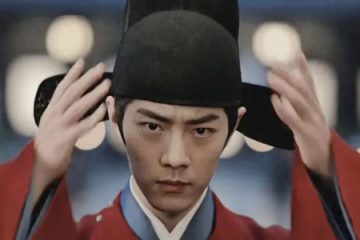The Eunuch Costumes in The Litchi Road

Does anyone know more about the unique historical role of eunuchs in ancient China? Lately, there’s been a lot of buzz around The Litchi Road, both the film and TV versions — but people have noticed that the eunuch characters wear different styles of their hanfu hats in each. So, which one is actually accurate?
Ⅰ. What Is a Eunuch?
In ancient China, eunuchs were a unique class of male servants who had been castrated and worked within the imperial court. Because they could not father children, they were seen as posing no threat to the royal bloodline and were therefore trusted to serve in sensitive areas like the inner palace and royal chambers.
Their duties ranged from attending to the emperor, empress, and concubines, to delivering verbal orders, managing palace affairs, and sometimes even participating in politics.
One well-known example comes from the film The Last Emperor, which shows the eunuchs of the late Qing Dynasty in the Forbidden City—an introduction to this system for many Western audiences.

Ⅱ. Eunuch Headwear
The tall, semi-transparent hat often associated with eunuchs has appeared in many historical dramas. While it has become a stereotypical symbol of eunuchs on screen, this type of hat was originally an official’s cap during the Tang Dynasty. Over time, the design evolved in various shows and films.
Historically, this kind of hat might be called a 笼巾 (woven headwrap) or 笼冠 (structured crown). Technically, “巾” refers to soft hats and “冠” to more rigid styles, but the two terms were often used interchangeably later on.

It’s important to note that the 笼冠 (structured crown) was never worn alone. In paintings like The Nymph of the Luo River and Portraits of Emperors Through the Ages, officials wearing the structured crown also had a flat cloth cap underneath. This inner cap was hidden beneath the tall structured crown, so it’s not easily visible.
(The Nymph of the Luo River↓)

(Portraits of Emperors Through the Ages↓)

Ⅲ. From Soft Hats to Hard Hats
This type of hat first appeared in the Han Dynasty. The woven headwrap found at Mawangdui was made of soft material—black lacquered fine mesh—also called the “lacquered mesh long guan (漆纱笼冠).” Later, during the Wei, Jin, and Northern and Southern Dynasties, it evolved into a hard, cage-like crown. The transition from soft cloth to hard crown was common.
Before the Southern Dynasties, military hats had short ear flaps that didn’t cover the ears. After that, the flaps grew longer to cover the ears, while the inner cloth cap shrank to only cover the top of the head. When worn with the outer mesh hat, the inner crown became almost invisible.

At first, the woven headwrap was worn by all social classes and genders—yes, you heard that right. During the Wei, Jin, and Northern and Southern Dynasties, both men and women wore this crown. Female attendants in Wei and Jin tombs are even depicted wearing it, with a cloth cap underneath the outer mesh.
Officials and palace attendants (who were also officials) commonly wore it too. By the Tang and Song Dynasties, it became mostly associated with officials and palace attendants, especially during important ceremonies and grand events.

When paired with the structured crown, the most appropriate outfit was typically the deep red gauze court robe. As shown in the image of Tang dynasty formalwear, this ensemble usually featured black trim, a dark red outer robe, a white underskirt, and a front panel that hangs below the waist.
According to the Old Book of Tang, court hanfu attire—also called “complete dress” (举服 in Chinese)—was worn for major ceremonies, while simpler public dress was used for less formal occasions. The full set included the crown, cloth cap, sash, hairpin, dark red gauze outer robe, white inner robe, black-trimmed collar and skirt, white under-skirt or skirt-shirt, leather belt, decorative hooks, formal collars, socks, shoes, sword, pendants, and ribbon ornaments.

In the Ming dynasty, eunuch headwear had more distinct features. During the early to mid-Ming period, their hats often had a gentle curve. By the mid to late Ming period, many eunuchs wore hats shaped like upright roof tiles. Both styles coexisted later on.
According to the Donghuan Fengshi (《东还封事》), eunuchs wore headgear made of bamboo wrapped in fabric. Higher-ranking eunuchs wore hats with brims that curved upward from the back, extending about an inch above the crown—giving them the appearance of standing roof tiles.

Summary
While watching the drama version of The Litchi Road, many viewers may notice that male characters rarely wear hats—almost everyone wears a futou (幞头, cloth headwrap) with a round-collared robe. This was actually everyday attire.
The movie version, however, shows a bit more variety. One eunuch character, Yu Changshi, wears a 笼冠 (structured crown) with a round-collared hanfu robe (see image, right). The combination looks a bit odd—almost like pairing a formal hat with workwear. But historically, unless it was a grand ceremonial event, the futou with a round-collared robe, like in the drama (left), would have been the more appropriate and common choice.
After watching, perhaps you’ve gained a clearer understanding of how eunuchs were dressed in different contexts.




0 Comments